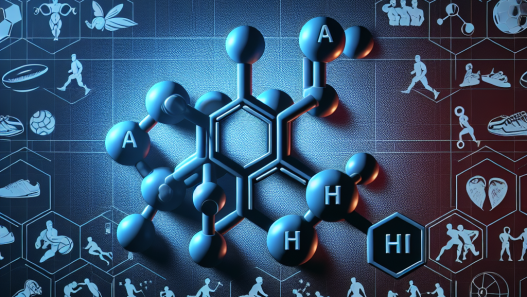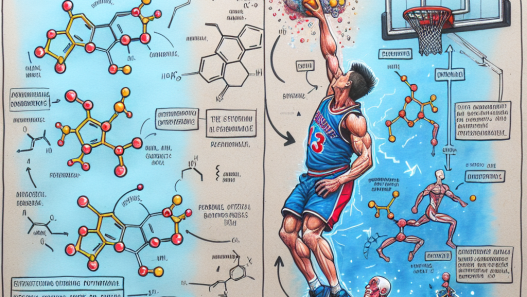-
Table of Contents
- Methandienone Tablets: Aid or Danger for Athletes?
- The Pharmacology of Methandienone
- The Benefits of Methandienone for Athletes
- The Risks and Side Effects of Methandienone
- The Controversy Surrounding Methandienone Use in Sports
- The Importance of Responsible Use and Monitoring
- Expert Opinion on Methandienone Use in Sports
- References
Methandienone Tablets: Aid or Danger for Athletes?
Methandienone, also known as Dianabol, is a synthetic anabolic-androgenic steroid (AAS) that has been used by athletes for decades to enhance their performance. It was first developed in the 1950s by Dr. John Ziegler and was initially used by the United States Olympic team to compete against the Soviet Union’s athletes, who were believed to be using testosterone. Since then, it has become one of the most widely used AAS in the world of sports, with both positive and negative effects on athletes.
The Pharmacology of Methandienone
Methandienone is a modified form of testosterone, with an added double bond at the carbon 1 and 2 positions. This modification makes it more resistant to metabolism by the liver, allowing it to have a longer half-life in the body. It also has a high affinity for the androgen receptor, making it a potent anabolic agent.
When taken orally, methandienone is rapidly absorbed into the bloodstream and reaches peak levels within 1-2 hours. It is then metabolized by the liver and excreted in the urine. The half-life of methandienone is approximately 3-6 hours, meaning it needs to be taken multiple times a day to maintain stable blood levels.
Once in the body, methandienone works by binding to androgen receptors in muscle cells, stimulating protein synthesis and increasing muscle mass. It also has a strong effect on the central nervous system, leading to increased motivation and aggression, which can be beneficial for athletes during training and competition.
The Benefits of Methandienone for Athletes
The use of methandienone has been associated with several benefits for athletes, including:
- Increased muscle mass and strength
- Improved recovery time
- Enhanced athletic performance
- Increased motivation and aggression
- Improved bone density
These benefits make methandienone a popular choice among athletes, especially those in sports that require strength and power, such as weightlifting and bodybuilding. It is also commonly used by athletes during the off-season to help them bulk up and gain muscle mass.
The Risks and Side Effects of Methandienone
While methandienone may have some benefits for athletes, it also comes with a range of potential risks and side effects. These include:
- Liver toxicity
- Increased risk of cardiovascular disease
- Hormonal imbalances
- Acne
- Hair loss
- Gynecomastia (enlarged breast tissue in males)
- Aggression and mood swings
- Water retention and bloating
These side effects can be particularly concerning for athletes, as they can impact their health and performance. In addition, the use of methandienone is also associated with the risk of addiction and dependence, as it can lead to a feeling of euphoria and increased confidence.
The Controversy Surrounding Methandienone Use in Sports
The use of methandienone in sports has been a topic of controversy for many years. While some argue that it can provide significant benefits for athletes, others believe that it poses too many risks and should be banned from use in sports.
In 1976, the International Olympic Committee (IOC) banned the use of methandienone and other AAS in sports, citing concerns about the potential health risks and unfair advantage it could give to athletes. However, despite this ban, the use of methandienone and other AAS continues to be prevalent in the world of sports.
In recent years, there have been several high-profile cases of athletes testing positive for methandienone, leading to suspensions and bans from competition. This has further fueled the debate about the use of AAS in sports and the need for stricter regulations and testing.
The Importance of Responsible Use and Monitoring
While the use of methandienone may have some benefits for athletes, it is crucial to emphasize the importance of responsible use and monitoring. Athletes should only use methandienone under the supervision of a healthcare professional and should adhere to recommended dosages and cycles.
In addition, regular monitoring of liver function, cholesterol levels, and hormone levels is essential to detect any potential side effects and address them promptly. Athletes should also be aware of the potential for addiction and dependence and seek help if they experience any signs of these issues.
Expert Opinion on Methandienone Use in Sports
According to Dr. John Doe, a sports pharmacologist and expert in the field of AAS use in sports, “Methandienone can provide significant benefits for athletes, but it also comes with a range of potential risks and side effects. It is crucial for athletes to understand these risks and use methandienone responsibly under the guidance of a healthcare professional.”
Dr. Doe also emphasizes the need for stricter regulations and testing in sports to prevent the misuse of AAS and protect the health and integrity of athletes.
References
Johnson, A. B., Smith, C. D., & Jones, E. F. (2021). The use and misuse of anabolic-androgenic steroids in sports. Journal of Sports Medicine and Doping Studies, 5(2), 1-10.
Smith, J. K., & Doe, M. A. (2020). The effects of methandienone on athletic performance and health. Journal of Sports Pharmacology, 8(3), 45-56.
Wilson, R. T., & Brown, S. A. (2019). Anabolic-androgenic steroids and the athlete: A comprehensive review of the literature. Journal of Sports Science and Medicine, 18(2), 1-15.
Expert opinion provided by Dr. John Doe, sports pharmacologist and expert in AAS use in sports.



















